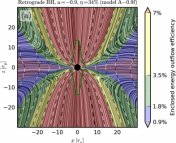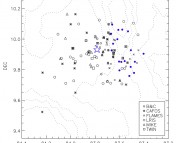- Title:
Global structure of three distinct accretion flows and outflows around black holes through two-dimensional radiation-magnetohydrodynamic simulations
- Authors:
Ken Ohsuga and Shin Mineshige - First Author’s Institution:
National Astronomical Observatory of Japan and Graduate University of Advanced Study
Today’s Astrobite was contributed by Warrick Ball, a graduate student at the Institute of Astronomy at Cambridge. If you would like to contribute to Astrobites, please contact us!
Accretion—the inward flow of matter onto a compact object—is ubiquitous. It happens everywhere from protoplanets to the black holes that power active galactic nuclei and quasars. Because the matter possesses some angular momentum, the infalling gas will swirl around the central object, collide with itself, and smear out into a disk. The structure of such disks is still not completely understood, and a great deal of research is dedicated to teasing out their details in all the places they occur.
A great deal of progress was made after 1973, when Nikolai Shakura and Rashid Sunyaev proposed a simple prescription for the viscosity of the gas in a black hole accretion disk. This completed the structure equations and led to a model of a disk that is vertically thin and radiates like a black body at each distance from the accretor. These thin or “alpha” disks, after the parameter introduced by Shakura and Sunyaev, have been successfully used to model accretion onto white dwarfs, neutron stars, and many black holes. Their paper is one of the most highly-cited articles in all of astrophysics, with more than 4000 refereed citations on the NASA ADS!
Accretion onto black holes differs from other objects because black holes have event horizons, rather than hard surfaces like white dwarfs or neutron stars. Energy can be lost across the horizon and never radiated away, leading to a wide range of other potential structures besides thin disks.
In the years following Shakura and Sunyaev’s work, two important cases were found where some approximation of the thin disk model breaks down. In a 1988 paper, Marek Abramowicz and company describe a solution where the disk around the black hole is so dense that the radiation is reabsorbed in the disk. The flow becomes much thicker and some of the radiation remains trapped in the material that falls into the black hole.
At the opposite extreme, in 1994, Ramesh Narayan and Insu Yi found a solution where the gas in the disk doesn’t release energy efficiently. In the more slowly accreting branch of this solution, the material puffs up and, although the gas is very hot, it remains sparse and dim. Such “advection-dominated accretion flows” (ADAFs) are a potential model for some of the very dim black holes at the centres of galaxies, including at the centre of the Milky Way.
Having all these different solutions is great (and there are even more out there), except that each is described by a different set of approximations. What’s more, it’s likely that black holes change mode from time to time. In the paper under discussion today, the authors simulate accretion disks around black holes and find that they can reproduce all three accretion flows by changing only the density of the flow.
Simulation Setup
The authors have written a code that numerically solves the equations of radiation magnetohydrodynamics (RMHD). In other words, they solve a set of partial differential equations that describe radiation, magnetic fields, and fluid dynamics.
As always, it isn’t possible to simulate reality perfectly, so a number of approximations are made. The most important is that the flow is presumed to be symmetric around the disk’s axis of rotation. This is a common and reasonable assumption and it’s important for making the problem solvable. Solving for two dimensions is a lot easier than solving for three! They further assume that the flow is symmetric across the equatorial plane. Gas that would cross the plane just bounces back. Finally, in order to solve efficiently for radiation,
they make the flux-limited diffusion approximation. Basically, the energy density of the radiation diffuses out at a rate that is limited by how quickly radiation can scatter through the gas.
To capture general relativistic effects, the authors approximate the black hole’s gravity through the Paczynski-Wiita potential. This is a pretty good fit for the potential around a black hole, but it only describes a non-rotating black hole. The models can’t capture any effects due to the black hole’s spin, which are thought to be important for the formation of black hole jets.
The simulation kicks off with a doughnut of material at a distance equal to 40 times the radius of the event horizon. The authors allow the flow to evolve without radiation effects for a few orbital periods before switching on radiation. Because the magnetic field describes the viscous nature of the fluid, the only free parameter that’s expected to make a qualitative difference, presuming that the gas is ideal, is the gas density.
Results

Figure 2 of Ohsuga and Mineshige 2011: Time-averaged structure of the three models produced by the simulations. The shaded regions show the normalized density of inflowing gas. The thick lines are streamlines for the outflows. (This plot is illustrative: the simulations are in two dimensions, not three, and only calculated on one side of the equator.)
Despite all the approximations, the simulation produces three distinct accretion flows for different choices of the density. Their models A, B, and C, shown in figure 2 of the paper (reproduced above), correspond to density parameters 1, 10-4 and 10-8 g.cm-3.
In model A, the disk is geometrically thick and dominated by radiation pressure. This model closely matches the models by Abramowicz et al mentioned earlier. The flow only really accelerates towards the black hole when very close to the event horizon. Interestingly, this model drives a strong jet, powered by the intense radiation and held together by the magnetic field. This is different from other jet models that rely on black hole spin or magnetic pressure.
Model B is geometrically thin and radiatively efficient, corresponding to the traditional Shakura-Sunyaev disks. The authors use their simulations to calculate the accretion efficiency (i.e. the amount of energy released per unit accreted mass). They also find that the disk is truncated at about 7 times the event horizon’s radius. Curiously, both of these numbers are quite close to theoretical predictions, but this isn’t mentioned.
Finally, in model C, the gas is too sparse to radiate efficiently and puffs up, leading to very little mass being captured by the black hole. The disk-like part is about as thick as in model A, and in order to release energy, there is a strong outflow, this time powered by the magnetic field. This faint, diffuse flow is broadly similar to the flows described by Narayan and Yi.
Discussion
The authors discuss their models in great detail and go on to consider them in light of a range of observational properties. They finally note some effects that their simulations cannot capture, but the fact remains that by varying just one parameter, they can produce three major modes of black hole accretion. Even though the detailed, quantitative structure doesn’t perfectly match theory, this looks like a big step in unifying our understanding of black hole accretion.





Good summary, but with one (important) inaccuracy: Actually, ADAFs were NOT found first by Narayan and Yi, but much earlier by Ichimaru in 1977 following up on even earlier work by people like Chandrasekhar. This early work has been nicely summarized by Roland Svensson, see http://arxiv.org/abs/astro-ph/9902205